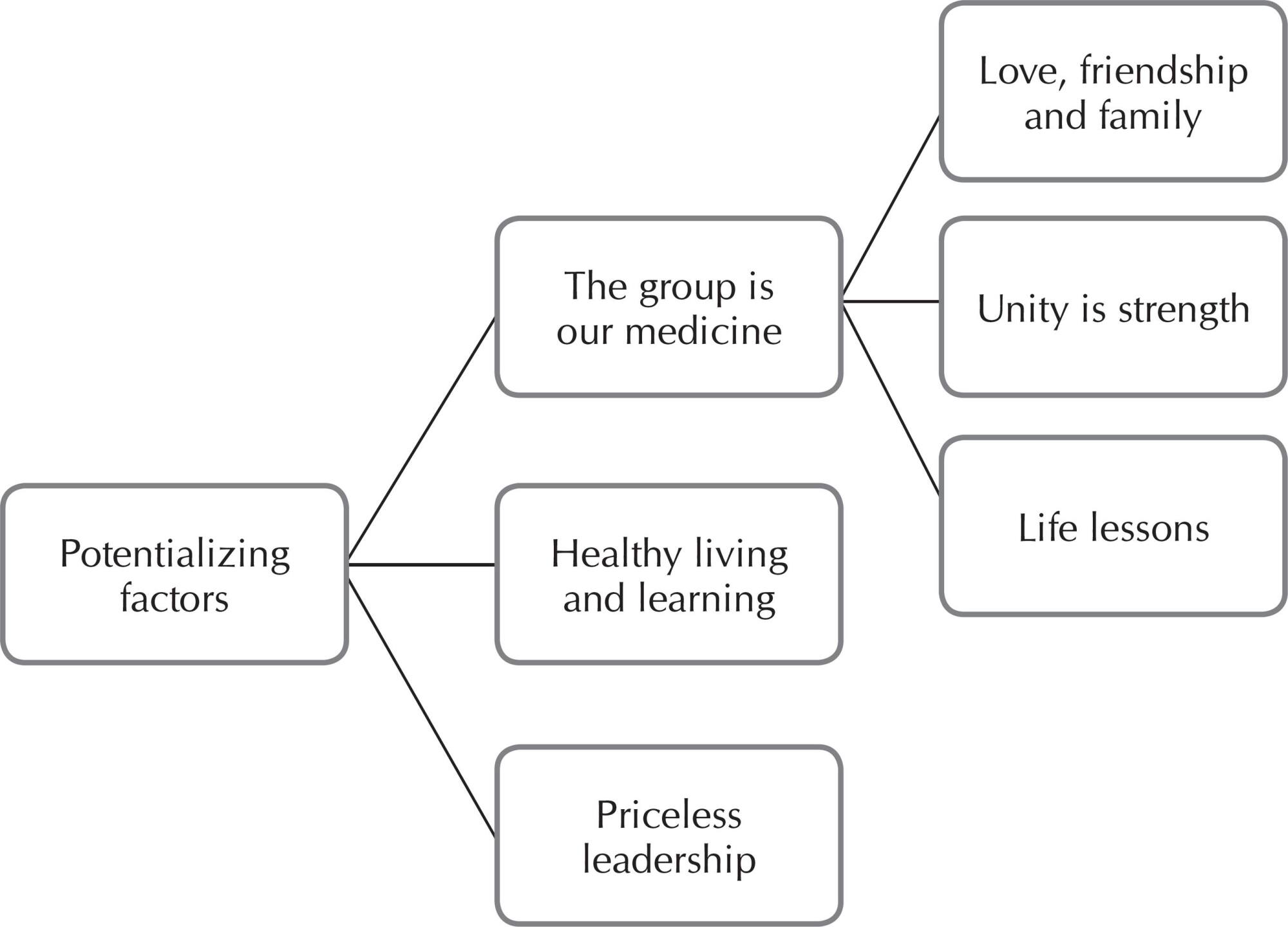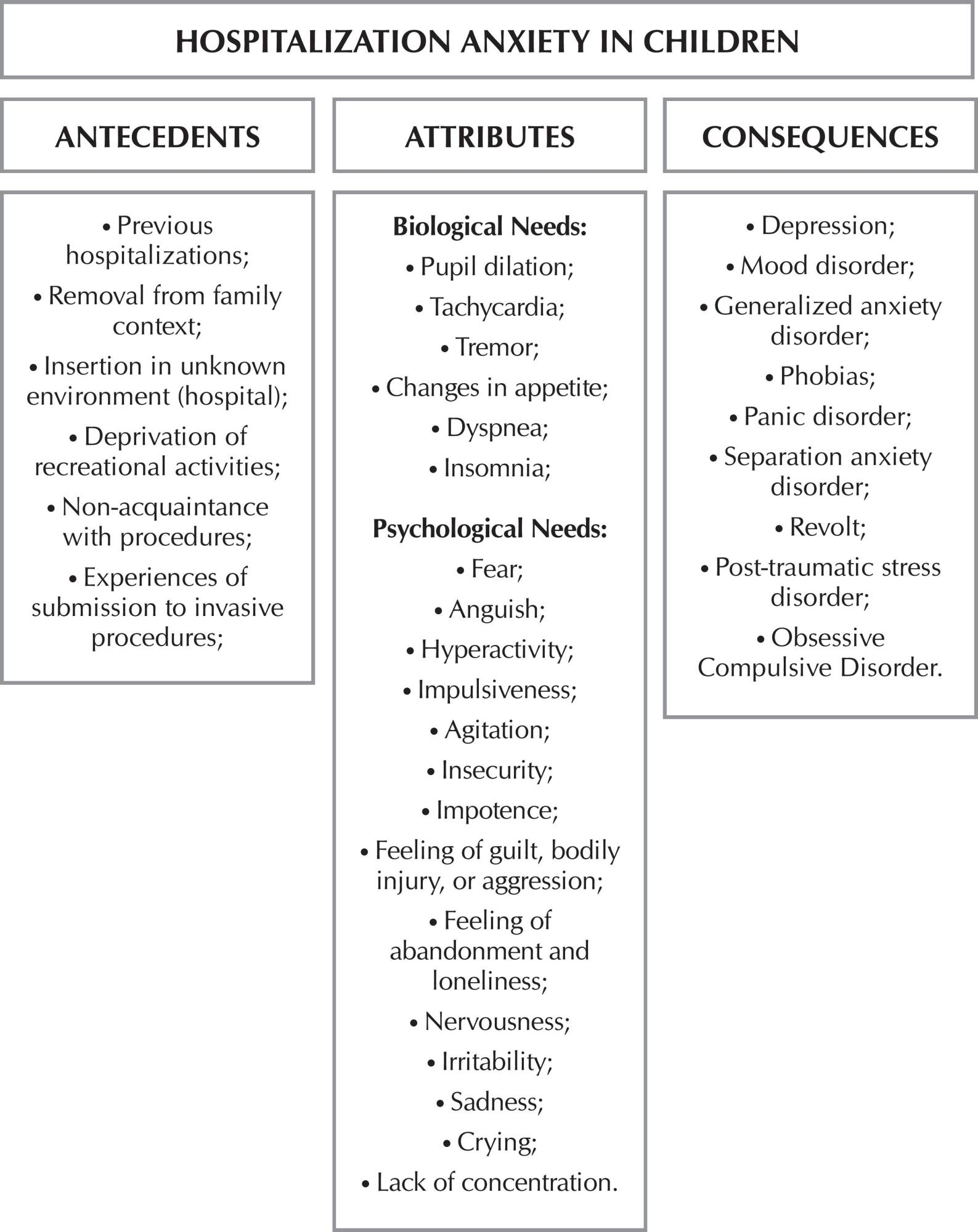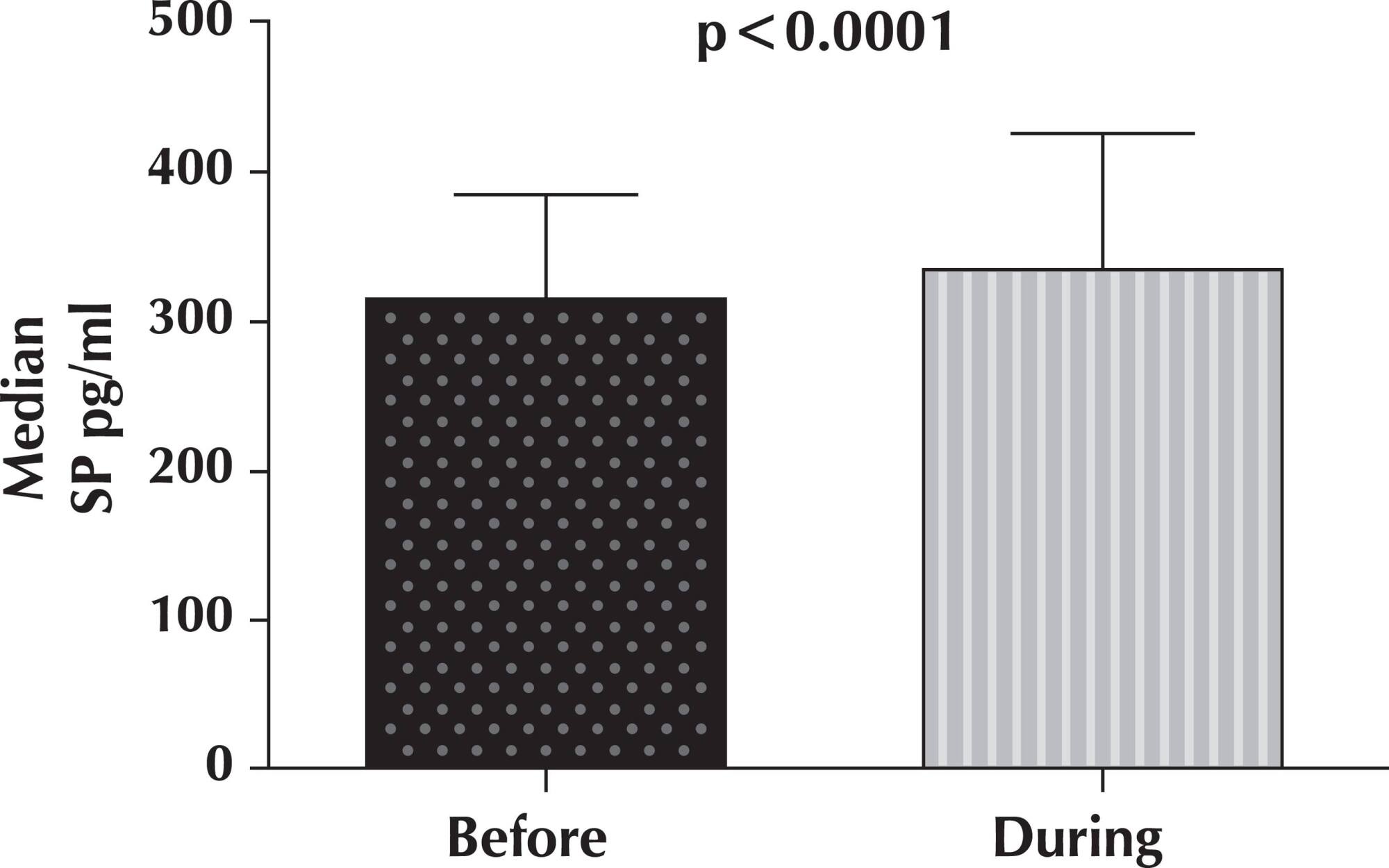-
01-01-2016
Leads for potentializing groups in Primary Health Care
Revista Brasileira de Enfermagem. 2016;69(5):964-971
Abstract
Leads for potentializing groups in Primary Health Care
Revista Brasileira de Enfermagem. 2016;69(5):964-971
DOI 10.1590/0034-7167-2015-0102
Views0See moreABSTRACT
Objective:
to analyze the aspects that potentialize groups in Primary Health Care according to their coordinators and participants.
Method:
This is a descriptive study with a qualitative approach, conducted with a health promotion group affiliated with a Family Health Unit. The data were collected by means of focus groups with participants and community workers who were submitted to thematic content analysis.
Results:
the analysis gave rise to three thematic categories: The group is our medicine; Healthy living and learning; and Priceless leadership.
Conclusion:
the leads identified during the study were as follows: group organization involves investment in motivation and leadership by the coordinators; production of grouping and cohesion is a result of participants and coordinators meeting together, interspersed with dialog, things said and left unsaid that the subjects expressed in the group dynamic; the sense of belonging guarantees their placement in the group based on the recognition of their knowledge and affective, social and health needs.

-
01-01-2016
The path to crack addiction: perceptions of people under treatment
Revista Brasileira de Enfermagem. 2016;69(5):956-963
Abstract
The path to crack addiction: perceptions of people under treatment
Revista Brasileira de Enfermagem. 2016;69(5):956-963
DOI 10.1590/0034-7167-2016-0045
Views0See moreABSTRACT
Objective:
the objective of this study was to understand the meaning of the harmful use of crack by people undergoing addiction treatment.
Method:
qualitative approach of social research on strategic modality was used. Field observation, preparation of field diary and focus groups, and data analysis through the method of interpreting meaning were carried out.
Results:
the results contributed to the construction of three thematic categories: “The discovery of crack and other drugs” that describes the experimentation with crack and other drugs; “The pain of the pleasure”, key category that describes the moments after crack experimentation and that, many times, turns into addiction, which leads the person into a cycle of short periods of attempts at abstinence, relapse, and relentless consumption; and “Return to normal life”.
Conclusion:
treating people with crack addiction must be carried out in ways that narrow the distance between these people and their families, society and health care.
-
01-01-2016
Intimate partner violence in adolescence: an analysis of gender and generation
Revista Brasileira de Enfermagem. 2016;69(5):946-955
Abstract
Intimate partner violence in adolescence: an analysis of gender and generation
Revista Brasileira de Enfermagem. 2016;69(5):946-955
DOI 10.1590/0034-7167-2016-0408
Views0See moreABSTRACT
Objective:
to analyze the intimate partner violence in adolescence from the perspective of gender and generation.
Method:
Quantitative, descriptive, and exploratory research. 111 adolescents participated in this study, with ages from 15 to 19 years old.
Results:
We found that 91% of participants have perpetrated and 90.1% have undergone at least one of the natures of violence. The intimate partner violence in adolescence constitutes a form of gender violence, and gender constructions have determined the suffered and perpetrated aggressions, possibly also determining the naturalization and legitimization of such aggressions. The inequality of power between generations may determine greater vulnerability of youngsters to the phenomenon.
Conclusion:
The historical and social construction of masculinity and femininity and the power inequalities set by these constructions converge with the power inequality between generations. Thus, gender and generation are determinants of intimate partner violence in adolescence, as well as of the vulnerability of adolescents to this phenomenon.
-
01-01-2016
Hospitalization anxiety in children: conceptual analysis
Revista Brasileira de Enfermagem. 2016;69(5):940-945
Abstract
Hospitalization anxiety in children: conceptual analysis
Revista Brasileira de Enfermagem. 2016;69(5):940-945
DOI 10.1590/0034-7167-2015-0116
Views0See moreABSTRACT
Objective:
to analyze the concept “hospitalization anxiety in children”, identifying its antecedents, attributes, and consequences, with the objective of clarifying its meaning.
Method:
we used a conceptual analysis model, whose objective is to clarify the meaning of terms.
Results:
we identified the concept antecedents and its attributes, classified as biological and psychological needs, which are essential characteristics of “hospitalization anxiety in children”. This process consequences have also been identified. We proceeded to the analysis of the characteristics with emphasis on the impacts of the hospitalization process on the child and on the family.
Conclusion:
based on the conceptual analysis of the phenomenon, it was possible to identify the antecedents, attributes, and consequences of Hospitalization Anxiety in children. We recommend the continuation of the study validating the essential characteristics presently identified as a way to join knowledge gathered and professional practice.

-
01-01-2016
Stroke: patient characteristics and quality of life of caregivers
Revista Brasileira de Enfermagem. 2016;69(5):933-939
Abstract
Stroke: patient characteristics and quality of life of caregivers
Revista Brasileira de Enfermagem. 2016;69(5):933-939
DOI 10.1590/0034-7167-2015-0064
Views0See moreABSTRACT
Objective:
to investigate the association between the domains of health-related quality of life of family caregivers and sociodemographic characteristics of individuals with stroke sequelae.
Method:
descriptive, cross-sectional, quantitative research, conducted with 136 family caregivers of individuals with stroke sequelae by means of home interviews from April to June 2013.
Results:
we found that caregivers of individuals aged under 65 years, married, with 10 to 12 years of formal education, presented higher scores, respectively, in the domains ‘Social aspects’, ‘Emotional aspects’, and ‘Mental health’. However, caregivers of patients with higher degree of disability obtained lower score in the ‘Mental Health’ domain.
Conclusion:
the results foster reflection on the need of including the family caregivers of individuals with stroke sequelae in the planning of care provided by health professionals.
-
01-01-2016
A quasi-experimental nursing study on pain in comatose patients
Revista Brasileira de Enfermagem. 2016;69(5):927-932
Abstract
A quasi-experimental nursing study on pain in comatose patients
Revista Brasileira de Enfermagem. 2016;69(5):927-932
DOI 10.1590/0034-7167-2015-0121
Views0See moreABSTRACT
Objective:
to verify whether comatose patients feel pain during the bed bath nursing procedure.
Method:
nineteen patients aged 61 ± 17.39 years participated in the study. A quantitative analysis was conducted on the P substance (PS) in the saliva collected before and during a bed bath, using the ELISA method. Program Graph Pad Prisma 6 was used to analyze the data. The verification of normality was made through the Shapiro Wilk test, which determined the choice for the Wilcoxon nonparametric test.
Results:
the study showed a statistically significant increase (∆= 5.62%, p<0.001) in the PS level of the patients studied during the nursing procedure.
Conclusion:
when caring for comatose patients during a bed bath, professionals cause or add painful stimuli; therefore, they feel pain.

-
01-01-2016
Quality of nursing care: instrument development and validation
Revista Brasileira de Enfermagem. 2016;69(5):920-926
Abstract
Quality of nursing care: instrument development and validation
Revista Brasileira de Enfermagem. 2016;69(5):920-926
DOI 10.1590/0034-7167-2015-0151
Views0See moreABSTRACT
Objectives:
to describe the development and validation process of a scale to measure the nurses’ perception of the activities that contribute to nursing care quality.
Method:
methodological study based on a literature review, the opinion of experts and the experience of study investigators. An instrument was designed containing six dimensions and 25 items, applied as a questionnaire to 775 nurses from a hospital in northern Portugal, from May to July 2014. The instrument validation used an exploratory factor analysis and an internal consistency assessment of each factor/dimension.
Results:
the factor analysis indicated the need to adjust the original composition of the scale, which then received one more dimension, totaling seven dimensions and the same 25 items, and presented a high internal consistency (Cronbach’s alpha of 0.940).
Conclusion:
the final version of the scale presents adequate psychometric properties, with potential use in future studies.
-
01-01-2016
Network and social support in family care of children with diabetes
Revista Brasileira de Enfermagem. 2016;69(5):912-919
Abstract
Network and social support in family care of children with diabetes
Revista Brasileira de Enfermagem. 2016;69(5):912-919
DOI 10.1590/0034-7167-2015-0085
Views0See moreABSTRACT
Objective:
to understand the influence of network and social support in the care of a child with type 1 diabetes.
Method:
qualitative study, with assumptions of ethnonursing, conducted in a reference service specialized in the treatment of diabetes, in 2014, in the city of Fortaleza, state of Ceará, Brazil. Twenty-six members of the family and their respective school children participated in the study. The process of collection and analysis followed the observation-participation-reflection model.
Results:
the analytical categories showed that the social network in the care of children with diabetes helped sharing of information and experiences, moments of relaxation and aid in the acquisition of supplies for treatment, with positive repercussions in the family context, generating well-being and confidence in the care of children with diabetes.
Conclusion:
the cultural care provided by nurses strengthens the network and social support because it encourages autonomy in the promotion of the quality of life of children with type 1 diabetes and their families.
-
EXPERIENCE REPORT01-01-2018
Clinical and epidemiological teaching of dengue through simulated practice
Revista Brasileira de Enfermagem. 2018;71(2):451-456
Abstract
EXPERIENCE REPORTClinical and epidemiological teaching of dengue through simulated practice
Revista Brasileira de Enfermagem. 2018;71(2):451-456
DOI 10.1590/0034-7167-2016-0503
Views2See moreABSTRACT
Objective:
to describe the experience of clinical teaching on dengue and the practice of epidemiological surveillance using problematization methodology.
Method:
report of experience on educational activity with undergraduate nursing students, held in March 2016, at a public university in the city of São Paulo, conceived in four stages: dialogic lecture, active search of Aedes aegypti, case study and simulation of nursing consultation to individuals with dengue.
Results:
The activity allowed to retrieve previous knowledge about the disease, respond to exercises that addressed different clinical situations and epidemiological surveillance, including in situ evaluation of possible mosquito outbreaks, and discuss the need to expand prevention and health of the individual and the community, the impact of the media in the dissemination of cases and the coping difficulties experienced in the different levels of attention.
Conclusion:
the methodology adopted enabled qualified training of students to cope with dengue.

-
ORIGINAL ARTICLE07-18-2022
Beliefs, knowledge, actions of nursing techniques in breastfeeding in pain management in immunization
Revista Brasileira de Enfermagem. 2022;75(6):e20210546
Abstract
ORIGINAL ARTICLEBeliefs, knowledge, actions of nursing techniques in breastfeeding in pain management in immunization
Revista Brasileira de Enfermagem. 2022;75(6):e20210546
DOI 10.1590/0034-7167-2021-0546
Views1See moreABSTRACT
Objective:
Understand the beliefs, knowledge, and actions of nursing technicians on breastfeeding as a form of non-pharmacological intervention to relieve pain in newborns and infants during immunization.
Methods:
Qualitative study carried out through semi-structured interviews with nine nursing technicians from three Basic Health Units in a city in the state of São Paulo. The theoretical approach of the Belief Model and the methodological framework of Thematic Analysis supported this study.
Results:
Three themes originated: Beliefs, Knowledge, and Actions of nursing technicians.
Final considerations:
Despite knowledge about the benefits of breastfeeding as the most effective method for relieving pain in newborns and infants during vaccination, their restrictive beliefs overrode the evidence, leading them to act in ways that discourage or prevent the mother from breastfeed during vaccination. Formal training is recommended to align with current evidence-based practices.
-
REVIEW12-08-2023
Educational technologies for accident prevention due to falls in childhood: a scoping review
Revista Brasileira de Enfermagem. 2023;76:e20220807
Abstract
REVIEWEducational technologies for accident prevention due to falls in childhood: a scoping review
Revista Brasileira de Enfermagem. 2023;76:e20220807
DOI 10.1590/0034-7167-2022-0807
Views2See moreABSTRACT
Objectives:
to map evidence on educational technology use for accident prevention due to falls in childhood.
Methods:
a scoping review, carried out in October and November 2022, in the MEDLINE, Web of Science, BDENF and CINAHL databases and LILACS bibliographic index. There was no delimitation of language or time. Data were extracted and analyzed descriptively by two independent researchers. The research protocol was registered in the Open Science Framework.
Results:
twenty-six studies were selected. Booklets, pamphlets and leaflets were the most used technologies, presenting health services as the most frequent environment to develop research on fall prevention. The technologies developed were important outcomes: increased knowledge of children, family members, caregivers, health and education professionals.
Conclusions:
educational technology use makes it possible to increase knowledge, adopt safe practices and reduce falls.

-
REVIEW03-15-2024
Resources for health literacy among caregivers of prematurely born children: a scoping review
Revista Brasileira de Enfermagem. 2024;77(1):e20230062
Abstract
REVIEWResources for health literacy among caregivers of prematurely born children: a scoping review
Revista Brasileira de Enfermagem. 2024;77(1):e20230062
DOI 10.1590/0034-7167-2023-0062
Views1See moreABSTRACT
Objectives:
to map the available evidence on resources used to promote health literacy among caregivers of prematurely born children during outpatient follow-up.
Methods:
the Joanna Briggs Institute’s scope review protocol was utilized. The search encompassed six databases, incorporating studies from 2012 to 2022.
Results:
the three included publications revealed that the resources employed are: mobile applications, phone calls, individual counseling, videos, educational pamphlets, and group discussions. Implementing an education protocol during the transition home enhances scientifically grounded health promotion rates.
Conclusions:
there is limited literature addressing the health literacy of these caregivers. The nursing team plays a crucial role in health education and in developing resources applicable to these families.

-
ORIGINAL ARTICLE01-13-2024
Social representations of oncologic surgery for patients with cancer
Revista Brasileira de Enfermagem. 2024;77(6):e20230273
Abstract
ORIGINAL ARTICLESocial representations of oncologic surgery for patients with cancer
Revista Brasileira de Enfermagem. 2024;77(6):e20230273
DOI 10.1590/0034-7167-2023-0273
Views2See moreABSTRACT
Objectives:
to analyze the social representations of patients with cancer regarding oncologic surgery.
Methods:
a qualitative study based on Social Representation Theory was conducted with 126 participants between October 2021 and May 2022 in a public hospital in Rio de Janeiro. A characterization questionnaire, free evocations of the inducing term “surgery”, and semi-structured interviews with 60 participants were applied. Data were analyzed using Microsoft Excel® and IRaMuTeQ.
Results:
the central core of the representation is composed of fear, cure, hope, and removing the disease. The analysis of interviews resulted in six classes that highlight the social changes caused by treatment as well as the need for a support network to cope with the surgical process.
Final Considerations:
the representations reflect fear and hope towards the procedure and the desire to remove the disease, thus translating the cure through surgery.

-
ORIGINAL ARTICLE01-13-2024
Nurses’ perspectives on the use of telemonitoring in the management of people with diabetes and hypertension
Revista Brasileira de Enfermagem. 2024;77(6):e20230481
Abstract
ORIGINAL ARTICLENurses’ perspectives on the use of telemonitoring in the management of people with diabetes and hypertension
Revista Brasileira de Enfermagem. 2024;77(6):e20230481
DOI 10.1590/0034-7167-2023-0481
Views3See moreABSTRACT
Objectives:
to understand the perspective of nurses on the use of telemonitoring in the management of people with type 2 diabetes mellitus and arterial hypertension in primary care.
Methods:
this qualitative research involved sixteen nurses from eight municipalities in Paraná. Data were collected between November 2022 and January 2023 through inperson or remote interviews, which were audio-recorded and subjected to content analysis.
Results:
according to the nurses, telemonitoring enhances users’ knowledge about these conditions, communication and connection with the team, and productivity. However, the lack of electronic resources and equipment, high staff turnover, low user adherence, and the limited availability of professional time present significant challenges.
Final Considerations:
the effective implementation and operation of telemonitoring in the management of people with diabetes and hypertension involve both potential benefits and barriers. It is essential to have the availability of human and technological resources, managerial support, and the commitment of professionals and users.
-
ERRATUM01-13-2024
ERRATUM
Revista Brasileira de Enfermagem. 2024;77(6):e2024n6e08
Abstract
ERRATUMERRATUM
Revista Brasileira de Enfermagem. 2024;77(6):e2024n6e08
DOI 10.1590/0034-7167.20247706e08
Views2In the article “Brazilian nursing specific situation, middle and micro-range theories: a bibliometric study”, with DOI number: , published in Revista Brasileira de Enfermagem, 2024;77(4):e20230520, Chart 1:Where it read:[…]See more -
ORIGINAL ARTICLE09-29-2022
Palliative care production for health professionals in the context of home care
Revista Brasileira de Enfermagem. 2022;75(1):e20210030
Abstract
ORIGINAL ARTICLEPalliative care production for health professionals in the context of home care
Revista Brasileira de Enfermagem. 2022;75(1):e20210030
DOI 10.1590/0034-7167-2021-0030
Views1See moreABSTRACT
Objectives:
to analyze palliative care production developed by health professionals to home care patients.
Methods:
this is an exploratory study, with a qualitative approach, using the transpersonal care theoretical framework. Thirteen interviews were conducted with health professionals and 18 observations were conducted on different cases. Content analysis was performed using MAXQDA©.
Results:
actions performed: maintenance and follow-up measures to people eligible for palliative care, in acts of dialogue and “listening” to caregivers and users, conducting guidelines for the care and self-care process, performing technical procedures, delivery of materials, referrals and medical prescriptions to users.
Final Considerations:
it is perceived the need for advances in the implementation of government policies in Brazil that insert palliative care into the Health Care Network through educational, managerial and care actions that ensure human dignity, thus allowing the development of these and other palliative care interventions.
Search
Search in:
Nuvem de Tags
Enfermagem (930)Cuidados de Enfermagem (269)Atenção Primária à Saúde (239)Idoso (208)Educação em Enfermagem (151)Segurança do Paciente (150)Saúde Mental (145)Educação em Saúde (139)Estudos de Validação (131)Qualidade de Vida (104)Tecnologia Educacional (100)Promoção da Saúde (99)COVID-19 (91)Criança (91)Família (87)Enfermagem Pediátrica (86)Saúde do Trabalhador (86)Adolescente (85)Saúde Pública (82)Estudantes de Enfermagem (77)



